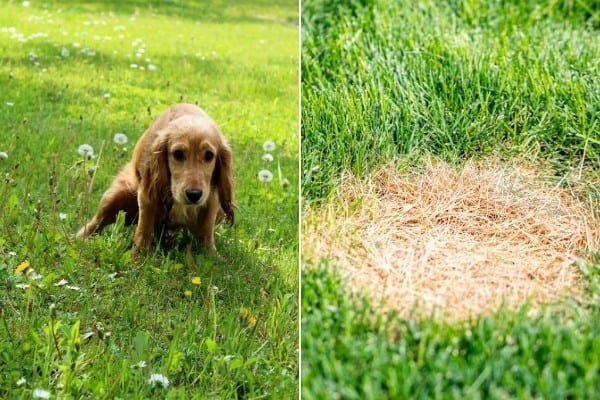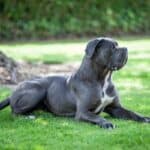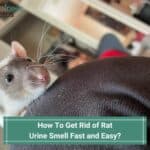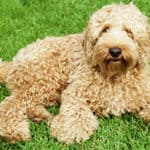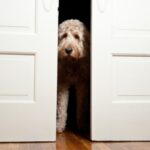There’s something wonderful about watching your dog romp around in a lush, grassy lawn.
However, you may find that before long, that lawn is becoming a lot less green, thanks to your dog’s potty habits.
Thankfully, there are some things you can do about it.
How do you stop dog urine from killing grass naturally? Good lawn care like aeration and regular watering, spraying urine spots down with water, training techniques, and landscaping for dogs are all great ways to stop dog urine from killing grass in a completely natural way.
If you want to have both a dog and a beautiful lawn (yes, it’s possible to have both), here are some straightforward and easily enacted tips to help.
Techniques to Stop Urine from Killing Grass
Spray Water after Your Dog has Urinated
One of the best ways to reduce the damaging effects of urine is to wash it away before it has time to scald the grass and affect the soil.
When you take your dog out, spray down wherever he has urinated with the garden hose to dilute the concentrated urine.
A spray nozzle with an adjustable flow control and various spray patterns, like this one on Amazon, is ideal rather than just using your thumb to direct the water spray.
You could take it a step further by adding a tablespoon or two of baking soda or lime to a bucket of water and using that to thoroughly douse the urine spot.
This will help to neutralize the excessive nitrogen and reduce damage.
Another good idea is to run a sprinkler after your dog has had the first bathroom break of the morning.
Treating with water won’t completely prevent all damage, but it will go a long way to reducing brown spots.
Don’t Use Fertilizer With Nitrogen on Your Lawn
If your lawn is already getting too much nitrogen in the form of dog urine, using fertilizer that contains nitrogen is only going to make things worse.
If you decide to use fertilizer, make sure that it does not have organic components that will break down into nitrogen.
Hint: The first of the three numbers listed on the bag or bottle indicates the amount of nitrogen. Look for a fertilizer with a zero as the first number, like Liquinox 0 – 10 – 10 Bloom.
Aerate and Water Regularly
A well-aerated lawn allows urine and water to penetrate directly down and into the soil below, which means that urine will be less likely to pool in the grass and more likely to be washed away by water.
Keep your lawn well-aerated by aerating every time you see urine or water pooling.
We recommend Montville Garden Lawn Aerator Shoes for this job. Simply buckle them on over your normal shoes and walk over the problem areas – no need for heavy, expensive machinery.
It’s best to water after your dog urinates on the lawn, but regardless, it is important to water regularly.
Seed Regularly
Regularly seeding your lawn whenever brown spots start to appear enables your grass to replace itself as quickly as it dies.
Whenever you find a bald spot, cover it in quality topsoil that is well-draining and does not have added nitrogen.
Add grass seed and prevent your dog from urinating on this area until the grass has recovered if at all possible.
Train Dogs Not to Pee on The Lawn
It is much easier to prevent urine scald from damaging your lawn if you teach your dog not to urinate on your lawn in the first place.
Some dogs can be very trainable when it comes to potty habits.
You’ve already trained your dog to go to the bathroom outside, so it really isn’t that much more to ask him to go somewhere specific or avoid a certain place.
That said, some individuals or breeds are much more difficult to potty train than others, indoors or outdoors.
Here are some steps to help you train your dog where to go.
- Hurry to the designated area as soon as you go out.
- Reward your dog with a highly desirable treat as soon as he goes in the designated area.
- Carefully supervise your dog whenever he has access to an area where you do not want him to urinate.
- If your dog is about to urinate on the lawn, gently correct him and lead him to where you want him to urinate.
- When your dog urinates in the designated area, reward him with highly desirable traits and praise.
- Be patient. It can be hard for dogs to understand the difference between your designated area and where they want to go, especially if they’ve been using the lawn for some time.
Some individual dogs and some breeds will be more difficult to train to use a designated potty area than others.
Harsh training mechanisms will not result in success and may teach your dog to hide their potty behavior from you, which makes future training even harder.
A better idea is to encourage your dog to avoid the lawn by removing the odors that are attracting him to the same spots over and over.
Simple Green Outdoor Odor Eliminator is an easy, effective way to do this.
It is nontoxic, can be applied directly to lawns, and uses natural enzymes to neutralize the urine smells that draw your dog to a particular area.
If you aren’t having success with training, fence off areas for your dog when you can’t supervise or use landscaping tactics to minimize the damage your dog causes.
(We have a fantastic list of deterrent methods to keep your dog from damaging specific area, like flower beds, in this article. Don’t miss it!)
Landscaping to Avoid Lawn Damage
By landscaping around your dog’s behavior, you can make it easier for dogs to learn where you want them to pee and where you don’t.
If your dog has particular habits, you can use them to make it easier to train him to go where you want him to go.
Here are a few examples of how you can use landscaping to protect your grass.
Mulch Places Your Dog Likes to Urinate
Does your dog like to lift their leg on shrubs and along the fence line?
Save yourself the trouble of trying to train them to pee elsewhere by mulching in these areas where it will not negatively affect the look of your garden.
This can be the best tactic for dogs who like to mark their territory by peeing along the perimeters.
Surround the Lawn with Border Plants
Some dogs are very particular about walking through long grass or pushing through shrubbery.
If your dog happens to be one of these prissy types, surrounding your lawn with a border that your dog won’t want to go through makes it much easier for him to learn to use the area you want him to use.
Choose a Hardy Grass
Some types of grass are more susceptible to urine scald than others.
You may find that perennial ryegrass or fescue are more likely to hold up to urine without severe scalds.
If the ground or your climate is damp and there is already moss competing with grass in areas where your dog likes to urinate, you may want to encourage the moss to create a thick sheet.
Moss can’t hold up to much digging or much foot traffic from your dog, but it might be more resistant to changes in the pH or urine scalding than any type of grass.
Of course, the most durable type of grass for your dog is artificial turf, but this is a big sacrifice to make in your home garden.
Make Designated Areas Attractive to Your Dog
Asking your dog to walk across gravel or some other uncomfortable surface to urinate is unlikely to have good results.
Artificial turf is an excellent solution to channel your dog’s urine away from soil and prevent it from damaging any vegetation.
If your dog doesn’t mind going on mulch, it can also be a great solution.
You can also hide a sacrificial patch of lawn from the view of the rest of the garden for your dog.
Put your designated area as close to the places where your dog normally wants to go as possible. You want to make it as easy for him as you can.
How to Tell if Dog Urine Is Killing The Grass
If the grass suddenly shows yellow or brown patches in coordination with you getting a new dog or your dog getting older and bigger, it’s a good sign that your dog is responsible.
When you tug the damaged grass, if it has strong roots, your dog is probably responsible for the damage.
If grass is turning yellow or brown for other reasons, it likely will have a weak root system.
However, grass that has been damaged from above will have a strong root system but be brown or yellow on top.
Why Does Dog Urine Damage Grass so Much?
Urine is very high in nitrogen. Grass needs nitrogen, and it is an essential fertilizer for all kinds of plants, but too high of a concentration can be damaging.
Furthermore, excessive urine can alter the soil’s pH, which may make the grass less healthy.
Dogs with an extremely acidic or alkaline pH may have more or less damaging effects on grass and the underlying pH.
However, products that claims to change the pH of your dog’s urine are unlikely to be effective.
Some owners claim that giving their dog filtered water has a beneficial effect, while others find that adding lots of fruits and vegetables to the diet results in an improvement.
You can certainly try some tactics like this.
Still, in reality, dog urine is naturally damaging to grass, and you are unlikely to be able to safely change your dog’s diet sufficiently to keep the urine from damaging the grass.

